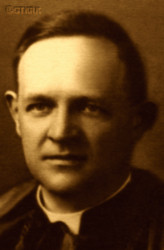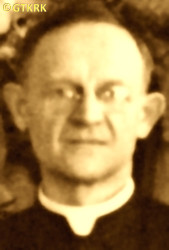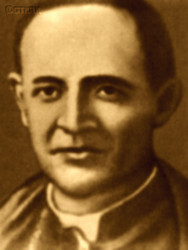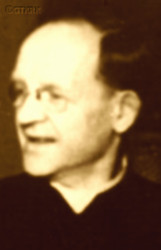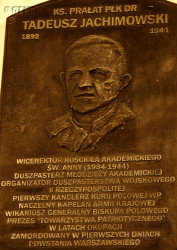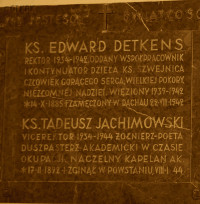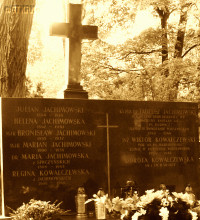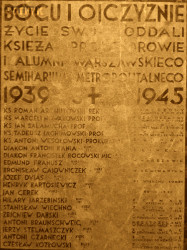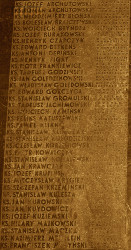Roman Catholic
St Sigismund parish
05-507 Słomczyn
85 Wiślana Str.
Konstancin deanery
Warsaw archdiocese, Poland
full list:
displayClick to display full list

searchClick to search full list by categories
wyświetlKliknij by wyświetlić pełną listę po polsku

szukajKliknij by przeszukać listę wg kategorii po polsku

Martyrology of the clergy — Poland
XX century (1914 – 1989)
personal data
surname
JACHIMOWSKI
forename(s)
Thaddeus Julian (pl. Tadeusz Julian)
function
diocesan priest
creed
Latin (Roman Catholic) Church RCmore on
en.wikipedia.org
[access: 2014.09.21]
diocese / province
Kielce diocesemore on
www.diecezja.kielce.pl
[access: 2012.12.28]
Warsaw archdiocesemore on
en.wikipedia.org
[access: 2013.05.19]
RC Military Ordinariate of Polandmore on
en.wikipedia.org
[access: 2014.12.20]
academic distinctions
Doctor of Philosophy
Sacred Theology MA
honorary titles
Papal super–numerary private honorary chamberlainmore on
en.wikisource.org
[access: 2020.12.11]
(1922)
honorary canonmore on
en.wikipedia.org
[access: 2014.11.14]
(c. 1926, Assumption of the Blessed Virgin Mary RC cathedral church, Kielcetoday: Kielce city pov., Holy Cross voiv., Poland
more on
en.wikipedia.org
[access: 2021.06.07])
„Polonia Restituta” Cross — 4th Class, Officer'smore on
en.wikipedia.org
[access: 2019.04.16]
(02.05.1923)
Gold „Cross of Merit”more on
en.wikipedia.org
[access: 2019.04.16]
(17.01.1938)
„Cross of Valour”more on
en.wikipedia.org
[access: 2019.04.16]
Ten Years of Independence Medalmore on
pl.wikipedia.org
[access: 2019.10.13]
Commemorative Medal for War of 1918–21more on
pl.wikipedia.org
[access: 2019.10.13]
date and place
of death
08.08.1944

Warsawtoday: Warsaw city pov., Masovia voiv., Poland
more on
en.wikipedia.org
[access: 2021.10.09]
alt. dates and places
of death
07.08.1944, 25.08.1944
details of death
From 12.04.1917, during World War I, after the February Revolution in Russia, which overthrew the tsarist regime, chaplain of Polish military units formed at the Russian army in Russia. Chaplain of the hospital at the 1st Polish Rifle Regiment, formed in Kiev on 02.1917 as part of the Polish Rifle Division (wearing Russian uniforms) — later also, on his own initiative, chaplain of the 2nd Polish Rifle Regiment in this division. Till 06.1917, the division trained near Proskuriv, after which it was sent to the front lines of the battles with the Central Powers, i.e. Germany and Austria–Hungary, to the vicinity of Husyatyn, where it took part in the last major offensive of Russian troops during World War I, on 01‐19.07.1917, known as the Kerensky Offensive. It fought near Berezhany not far from Ternopil. The offensive collapsed and on 18.07.1917 the division was disbanded.
From c. 24.07.1917 chaplain of the hospital at the 1st Polish Rifle Division, part of the 1st Polish Corps in Russia (Rus. 1‐й Польский корпус), subordinate to the Army of the Russian Empire (i.e. its Provisional Government), formed mainly on the basis of the remaining soldiers of the Polish Rifle Division (some of them deserted and went over to the German/Austro–Hungarian side), under the command of Gen. Joseph Dowbor–Muśnicki. Next chaplain of the 4th Polish Rifle Regiment within that division. From 15.09.1917 chaplain of the entire 1st Division, in the rank of dean, and at the same time chaplain of the 2nd Polish Rifle Regiment.
After the Bolshevik Revolution in Russia (10.1917), the Corps, still in the process of being formed, in 01.1918 came into conflict with the Bolsheviks, who began to sabotage the formation of the Corps — especially after the armistice between Germany and Bolshevik Russia on 17.12.1917. Despite this, the Corps completed its concentration near Bobruysk in Belarus. On 29.01‐03.02.1918 the Corps captured Bobruysk, driving out the Bolsheviks, winning several victories in nearby clashes, and on 19.02.1918 captured Minsk. At the beginning of 03.1918 the Bolsheviks were driven back beyond the Dnieper.
Took part in these struggles, i.a. on 04.02.1918, near Toloshchytsya, east of Bobruysk, took command of a brigade and successfully ended a skirmish with the Bolsheviks.
A month later, on 03.03.1918 in Brest, the Central Powers signed a separatist peace treaty with Bolshevik Russia. This put the Corps in a difficult situation — wedged between two sides (on 27.02.1918, the Corps surrendered Minsk to the Germans). On 04.03.1918, the Corps recognized the political authority of the Regency Council of the Kingdom of Poland supervised by the Central Powers, counting on maintaining independence. On 10.04.1918 however, under pressure from the Germans, the demobilization of the Corps began; on 21.05.1918, in Bobruysk, the Corps was — under threat of force — disbanded and disarmed. The last soldiers of the Corps left Bobruysk on 08.07.1918.
Returned then to his home diocese, becoming a prefect in Miechów.
After the armistice and ceasefire between the Allies and the Central Powers signed on 11.11.1918 in the staff wagon in Compiègne, at the headquarters of Marshal Ferdinand Foch of France — which meant the de facto end of World War I; after Brigadier Joseph Piłsudski took over supreme control of the emerging Polish army, as its commander‐in‐chief — which meant the de facto rebirth of the Polish state — joined the Polish Army (actually joined the budding units of the future Polish army three days earlier, i.e. on 08.11.1918). From 21.01.1919 the head of the chancellery, i.e. regent of the Field Ministry, on 03.03.1919 transformed into the Bishop's Curia of the Polish Army — and from 22.04.1919 first chancellor of that Curia. In this role took part in the struggles of the reborn Poland for its borders, in particular in the Polish–Russian War of 1919‐1921.
After German invasion of Poland on 01.09.1939 (Russians invaded Poland 17 days later) and start of the World War II participant of Warsaw siege by the Germans — brought spiritual help to the wounded, spoke with words of encouragement in Polish Radio broadcasts.
After start of German occupation arrested by the Germans on 05.10.1939 and held as a hostage in Pawiak prison, together with c. 250 Catholic priests and clerics, prob. as prevention before triumphal arrival of German socialist leader, Adolf Hitler, to captured Warsaw.
Released in 04.1940.
From then on — in connection with the arrest of Fr Edward Detkens — rector of the St Anne church in Warsaw.
Since 1941, participant in conspiratorial activities focused in the Polish Clandestine State. From mid‐1941, chaplain of the Union of Armed Struggle ZWZ (part of the Polish Clandestine State). Lecturer at the clandestine Theological Seminary in Warsaw and at the Faculty of Humanities of the clandestine University of the Western Lands (continuation of the University of Poznań closed by the Germans). Founder and chairman of clandestine Patriotic Society. Chief chaplain of the Union of Armed Struggle ZWZ. From 05.02.1943 — based on formal jurisdiction of 12.1942 — head of the Chief Chaplaincy of the Armed Forces „Nakasz” in Department I (Organizational) at Main Command of the Home Army AK and Chief Chaplain of AK. Creator of the clandestine Field Curia of AK, under nom‐de‐guerre „Budwicz” — from Pope Pius XII and Apostolic See obtained the so‐called Lat. „Facultates specials”, i.e. special wartime privileges for AK field chaplains.
From 27.07.1943 vicar general and Deputy Field Bishop.
Member and then from 23.05.1943 the chairman of the clergy committee of the Department of Religious Affairs of clandestine Government Delegation for Poland. From 09.01.1944 member of the Council of National Unity.
After outbreak on 01.08.1944 of Warsaw Uprising did not managed to reach an allocated concentration point.
Apprehended on 07.08.1944 by the Germans and attached to a group of civilians driven to the railway ramp in Warsaw–Wola.
Shut in St Stanislav the Bishop and Martyr church.
Next day in the morning escorted to the transport train — then one of the German guards dragged him out of the ranks and killed with a gun (in a yard of a burnt out building at Wolska Str., in the vicinity of St Stanislav the Bishop and Martyr church).
cause of death
mass murder
perpetrators
Germans
sites and events
Wola district massacresClick to display the description, Warsaw UprisingClick to display the description, GeneralgouvernementClick to display the description, Collective responsibility („Hostages”)Click to display the description, Ribbentrop‐MolotovClick to display the description, Pius XI's encyclicalsClick to display the description, Polish‐Russian war of 1919‐1921Click to display the description
date and place
of birth
17.02.1892Birth certification on:
metryki.genbaza.pl
[access: 2025.08.19]

Kazimierza Małatoday: Kazimierza Wielka gm., Kazimierza Wielka pov., Holy Cross voiv., Poland
more on
en.wikipedia.org
[access: 2022.01.28]
parents
JACHIMOWSKI Julian
🞲 1864, ? — 🕆 1928, ?

KOBYLAŃSKA Helen
🞲 1867, ? — 🕆 1941, ?
baptism
25.02.1892Birth certification on:
metryki.genbaza.pl
[access: 2025.08.19]

Kazimierza Małatoday: Kazimierza Wielka gm., Kazimierza Wielka pov., Holy Cross voiv., Poland
more on
en.wikipedia.org
[access: 2022.01.28]
Assumption of the Blessed Virgin Mary RC church
presbyter (holy orders)
ordination
13.09.1914

Kielcetoday: Kielce city pov., Holy Cross voiv., Poland
more on
en.wikipedia.org
[access: 2021.06.07]
positions held
1940 – 1944
rector — Warsawtoday: Warsaw city pov., Masovia voiv., Poland
more on
en.wikipedia.org
[access: 2021.10.09] ⋄ St Anne RC church ⋄ Warsaw‐in‐urbedeanery name
today: Warsaw city pov., Masovia voiv., Poland RC deanery — underground activist of the Polish Clandestine State, lecturer at clandestine schools, i.a. at clandestine Warsaw Theological Seminary, and the University of the Western Lands (part of the Polish Clandestine State) — details in the general description
c. 1939 – c. 1940
vice–rector — Warsawtoday: Warsaw city pov., Masovia voiv., Poland
more on
en.wikipedia.org
[access: 2021.10.09] ⋄ St Anne RC church ⋄ Warsaw‐in‐urbedeanery name
today: Warsaw city pov., Masovia voiv., Poland RC deanery — academic minister
1934 – c. 1939
vicar — Warsawtoday: Warsaw city pov., Masovia voiv., Poland
more on
en.wikipedia.org
[access: 2021.10.09] ⋄ St Anne RC church ⋄ Warsaw‐in‐urbedeanery name
today: Warsaw city pov., Masovia voiv., Poland RC deanery — academic chaplain and chaplain of academic association; also: chief chaplain of the Union of the „Falcon” Gymnastic Societies (from 1936, earlier from 1925 chaplain of the Mazovian District of the „Falcon” Gymnastics Society), censor of religious books (Lat. censores librorum)in the Archbishop's Curia (1935‐1939), prefect of public and private schools (c. 1935) — including of the Warsaw School of Nursing at 78 Koszykowa Str., the private Hedwig Taczanowska's Gymnasium and Lyceum for Girls at 149 Marszałkowska Str. and the School of Economics at Elektoralna Str., editor of the monthly „Catholic Youth”, advisor to the chapters of the „Juventus Christiana” Association of Catholic Youth at the Warsaw University of Life Sciences and the Warsaw School of Economics, head of the religious section at the Polish Radio, expert of the Press Commission of the Polish Episcopate
lecturer — Warsawtoday: Warsaw city pov., Masovia voiv., Poland
more on
en.wikipedia.org
[access: 2021.10.09] ⋄ homiletics, Metropolitan Theological Seminary
from 1934
retired (i.e. „at rest”) — Polish Armed Forces
1926 – 1933
official (i.e. bishop's judicial vicar) — Warsawtoday: Warsaw city pov., Masovia voiv., Poland
more on
en.wikipedia.org
[access: 2021.10.09] ⋄ Bishop's Court Martial
1919 – 1933
chancellor — Warsawtoday: Warsaw city pov., Masovia voiv., Poland
more on
en.wikipedia.org
[access: 2021.10.09] ⋄ Bishop's Curia of the Polish Military, Polish Armed Forces — actually from 22.04.1919 (earlier from 21.01.1919 the head of the chancellery, i.e. regent of the Field Consistory); commissioned military chaplain; by decree of the Chief of State of 03.05.1922, confirmed with seniority from 01.06.1919 and 3rd place on the list of Roman Catholic military deans, in the rank of colonel; 16.12.1921, by decree No. L. 3448 of the Commander‐in‐Chief, verified with seniority from 01.04.1920 and 6th place on the list of Roman Catholic military deans, in the rank of colonel; by L. 2683 decree of the Commander‐in‐Chief of 14.04.1921, at the request of the Bishop's Curia of the Polish Army, demobilised from the Polish Army; also: member of the Administrative and Economic Council and censor of religious books (Lat. censores librorum) of the Military Curia, editor and publisher of „Polish Soldier” (from 10.1920) magazine and founder and editor‐in‐chief of „Quarterly devoted to the Catholic Military Chaplaincy in Poland matters” (1931‐1934)
till 1923
PhD student — Warsawtoday: Warsaw city pov., Masovia voiv., Poland
more on
en.wikipedia.org
[access: 2021.10.09] ⋄ Department of Catholic Theology, University of Warsaw [i.e. University of Warsaw (from 1945) / clandestine University (1939‐1945) / Joseph Piłsudski University (1935‐1939) / University of Warsaw (1915‐1935) / Imperial University of Warsaw (1870‐1915)] — PhD thesis „Documents for the nomination of Joseph Gołuchowski as professor of philosophy at Vilnius University”, public defense in 1923
23.12.1918 – 21.01.1919
RC military dean — Kielcetoday: Kielce city pov., Holy Cross voiv., Poland
more on
en.wikipedia.org
[access: 2021.06.07] ⋄ Command of the General District DOG „Kielce”, Polish Armed Forces — acting („ad interim”)
1918
RC military chaplain — Miechówtoday: Miechów gm., Miechów pov., Lesser Poland voiv., Poland
more on
en.wikipedia.org
[access: 2021.06.07] ⋄ Miechów garrison, Polish Armed Forces — began his ministry on 08.11.1918, when the Polish Army did not yet exist and the garrison was located within the Germ. Militärgeneralgouvernement in Polen (Eng. General Military Government in Poland), i.e. managed by the Austro–Hungarian Empire and subordinate to the Army of the Austro–Hungarian Empire
1918 – 1919
prefect — Miechówtoday: Miechów gm., Miechów pov., Lesser Poland voiv., Poland
more on
en.wikipedia.org
[access: 2021.06.07] ⋄ Thaddeus Kościuszko Realgymnasium ⋄ Lord's Sepulchre RC parish ⋄ Miechówtoday: Miechów gm., Miechów pov., Lesser Poland voiv., Poland
more on
en.wikipedia.org
[access: 2021.06.07] RC deanery
1918 – 1919
vicar — Luborzycatoday: Kocmyrzów‐Luborzyca gm., Kraków pov., Lesser Poland voiv., Poland
more on
en.wikipedia.org
[access: 2021.12.18] ⋄ Exaltation of the Holy Cross RC parish ⋄ Luborzycatoday: Kocmyrzów‐Luborzyca gm., Kraków pov., Lesser Poland voiv., Poland
more on
en.wikipedia.org
[access: 2021.12.18] RC deanery — formal posting
1917 – 1918
RC military chaplain — 1st Polish Riflemen Division, 1st Polish Corps in Russia — in the rank of dean; also: chaplain of the 2nd Polish Rifle Regiment in the Corps; after the Bolshevik putsch in 10.1917 in Russia, an autonomous unit fighting the Bolsheviks, disbanded and disarmed by the Germans on 21.05.1918 in Bobruysk
1917
RC military chaplain — Imperial Russian Army — 02.1917‐18.07.1917 chaplain of the hospital of the 1st Polish Rifle Regiment in the Polish Rifle Division, also chaplain of the 2nd Polish Rifle Regiment in that formation; then from c. 24.07.1917 chaplain of the hospital of the 1st Polish Rifle Division in the 1st Polish Corps in Russia, and next chaplain of the 4th Polish Rifle Regiment in the same division; from 15.09.1917 chaplain of the entire 1st Division, in the rank of a dean, and at the same time chaplain of the 2nd Polish Rifle Regiment
1913 – 1917
student — Sankt Petersburgtoday: Saint Petersburg city, Russia
more on
en.wikipedia.org
[access: 2020.07.31] ⋄ philosophy and theology, Imperial Roman Catholic Spiritual Academy (1842‐1918) — postgraduate specialised studies, crowned in 06.1917 with the title of master of sacred theology
c. 1908 – 1913
student — Kielcetoday: Kielce city pov., Holy Cross voiv., Poland
more on
en.wikipedia.org
[access: 2021.06.07] ⋄ philosophy and theology, Theological Seminary
author of sermons delivered on Polish Radio; author of many specialist works in the field of pastoral care and philosophy; several historical publications; prayer books, e.g. „Żołnierz Chrystusa” (Eng. „Soldier of Christ”); two volumes of poetry, including „Półtony” (Eng. „Halftones”), Vilnius 1925; author of articles in the magazine „Żołnierz Polski” (Eng. „Polish Soldier”); 1931‐1934 founder and editor–in–chief of the „Quarterly devoted to matters of Catholic Military Chaplaincy in Poland”; translator of, among others, „On the Concepts of Philosophy in Pentateuch. Theological Treatises” by the Roman philosopher, St Boethius; author of sermons and funeral speeches of many famous personalities
membership — Study of the History of Philosophy in Poland Committee, Polish Academy of Learning PAU — also: member of Society for the Encouragement of Fine Arts in Warsaw
others related
in death
BEDNARZClick to display biography Francis (Bro. Josaphat), BOGACZClick to display biography Steven (Bro. Steven), DOLEŻALClick to display biography Ferdinand, DOLIŃSKIClick to display biography Thaddeus, DUDAClick to display biography Felix (Bro. Aquinas), DZIERZGWAClick to display biography Marian, GÓRSKIClick to display biography Edmund Simon, KACZEWSKIClick to display biography Francis, KALISZEWICZClick to display biography Anthony, KANIAClick to display biography Joseph Ignatius, KAPUSTAClick to display biography Joseph, KOLAKClick to display biography Stanislav (Bro. Bogumil), KOTYŃSKIClick to display biography Henry, KRYGIERClick to display biography Mieczyslav, KRZYWIŃSKIClick to display biography Stanislav (Bro. Raphael), KULESZAClick to display biography Stanislav, MAJGIERClick to display biography Francis, MALISZClick to display biography Vladislav Lawrence, MĄCZKAClick to display biography Stanislav Andrew, MIKOŁAJSKIClick to display biography Leo (Bro. Ambrose), MOTYKAClick to display biography Boleslav, MÜLLERClick to display biography Thaddeus, NOWAKOWSKIClick to display biography John, PALEWSKIClick to display biography Joseph, PONIEWIERSKIClick to display biography Joseph (Bro. Philip), PROTASIEWICZClick to display biography Theodos (Fr Teophan), RACZKOClick to display biography Raphael Conrad John, ROMANClick to display biography Louis (Bro. Cornelius), RUCIŃSKIClick to display biography Anthony, SANIKOWSKI–DZIEGIEĆClick to display biography Leonard, SZYMLIKClick to display biography John, SZYMSKIClick to display biography Anthony, ŚWIERCZEKClick to display biography John Nepomucene, TRZECIAKClick to display biography Stanislav Kostka, WERESZCZYŃSKIClick to display biography Bronislav, ZASADNIClick to display biography Francis, CIESIOŁKIEWICZClick to display biography Roman
sites and events
descriptions
Wola district massacres: Mass extermination of the inhabitants of Warsaw Wola and Ochota districts, perpetrated by the Germans in the first days of Warsaw Uprising. Approx. 38,000‐65,000 Poles, men, women and children were massacred (the peak of the barbarian killings took place on 05‐07.08.1944). The massacre — genocide in fact — was in direct response to Adolf Hitler’s order to crash and destroy Warsaw and kill all of its citizens and was perpetrated by German SS units and Russian SS RONA units (with Belarusian contingent) collaborating with them. (more on: pl.wikipedia.orgClick to attempt to display webpage
[access: 2021.12.19])
Warsaw Uprising: Lasted from 01.08.1944 till 03.10.1944. Was an attempt to liberate Polish capital from occupying Germans by the Polish Clandestine State — a unique in the history of the world political structure on the territories occupied by the Germans, effectively governing clandestinely in Poland — and by fighting on its behalf underground military units, mainly of Home Army (former Armed Struggle Association ZWZ) and National Armed Forced (NSZ). At the same time Russians stopped on purpose the offensive on all front, halted on the other bank of Vistula river and watched calmly the annihilation of the city, refusing even the mid‐landing rights to the Allied planes carrying weapons and supplies to the insurgents from Italy. During the Uprising Germans murdered approx. 200,000 Poles, mainly civilians. Approx. 200 priests and nuns died in fighting or were murdered by the Germans, many in mass executions. (more on: en.wikipedia.orgClick to attempt to display webpage
[access: 2013.08.17])
Generalgouvernement: After the Polish defeat in the 09.1939 campaign, which was the result of the Ribbentrop‐Molotov Pact and constituted the first stage of World War II, and the beginning of German occupation in part of Poland (in the other, eastern part of Poland, the Russian occupation began), the Germans divided the occupied Polish territory into five main regions. In two of them new German provinces were created, two other were incorporated into other provinces. However, the fifth part was treated separately, and in a political sense it was supposed to recreate the German idea from 1915 (during World War I, after the defeat of the Russians in the Battle of Gorlice in 05.1915) of creating a Polish enclave within Germany. Illegal in the sense of international law, i.e. Hague Convention, and public law, managed by the Germans according to separate laws — especially established for the Polish Germ. Untermenschen (Eng. subhumans) — till the Russian offensive in 1945 it constituted part of the Germ. Großdeutschland (Eng. Greater Germany). Till 31.07.1940 formally called Germ. Generalgouvernement für die besetzten polnischen Gebiete (Eng. General Government for the occupied Polish lands) — later simply Germ. Generalgouvernement (Eng. General Governorate), as in the years 1915‐1918. From 07.1941, i.e. after the German attack on 22.06.1941 against the erstwhile ally, the Russians, it also included the Galicia district, i.e. the Polish pre‐war south‐eastern voivodeships. A special criminal law was enacted and applied to Poles and Jews, allowing for the arbitrary administration of the death penalty regardless of the age of the „perpetrator”, and sanctioning the use of collective responsibility. After the end of the military conflict of the World War UU, the government of the Germ. Generalgouvernement was recognized as a criminal organization, and its leader, governor Hans Frank, guilty of war crimes and crimes against humanity and executed. (more on: en.wikipedia.orgClick to attempt to display webpage
[access: 2024.12.13])
Collective responsibility („Hostages”): A criminal practice implemented by the Germans in the occupied territories of Poland, applied from the very first day of World War II. At its core was an appointment and public announcement of a list of names of selected people whose lives depended on absolute compliance with German orders. Any violation of these ordinances, by any person, regardless of the circumstances, resulted in the murder of the designated „hostages”. In the first days of the war and occupation, it was used i.a. by the German Wehrmacht army to prevent acts of continuation of the defense by the Poles. Later, especially in the German‐run General Governorate, it was part of the official policy of the occupation authorities — collective responsibility for any acts of resistance to the occupier's practices. For the life of one German, even if death was due to customary reasons, the Germans carried out executions from a dozen to even a hundred Poles previously designated as „hostages”.
Ribbentrop‐Molotov: Genocidal Russian‐German alliance pact between Russian leader Joseph Stalin and German leader Adolf Hitler signed on 23.08.1939 in Moscow by respective foreign ministers, Mr. Vyacheslav Molotov for Russia and Joachim von Ribbentrop for Germany. The pact sanctioned and was the direct cause of joint Russian and German invasion of Poland and the outbreak of the World War II in 09.1939. In a political sense, the pact was an attempt to restore the status quo ante before 1914, with one exception, namely the „commercial” exchange of the so‐called „Kingdom of Poland”, which in 1914 was part of the Russian Empire, fore Eastern Galicia (today's western Ukraine), in 1914 belonging to the Austro‐Hungarian Empire. Galicia, including Lviv, was to be taken over by the Russians, the „Kingdom of Poland” — under the name of the General Governorate — Germany. The resultant „war was one of the greatest calamities and dramas of humanity in history, for two atheistic and anti‐Christian ideologies — national and international socialism — rejected God and His fifth Decalogue commandment: Thou shall not kill!” (Abp Stanislav Gądecki, 01.09.2019). The decisions taken — backed up by the betrayal of the formal allies of Poland, France and Germany, which on 12.09.1939, at a joint conference in Abbeville, decided not to provide aid to attacked Poland and not to take military action against Germany (a clear breach of treaty obligations with Poland) — were on 28.09.1939 slightly altered and made more precise when a treaty on „German‐Russian boundaries and friendship” was agreed by the same murderous signatories. One of its findings was establishment of spheres of influence in Central and Eastern Europe and in consequence IV partition of Poland. In one of its secret annexes agreed, that: „the Signatories will not tolerate on its respective territories any Polish propaganda that affects the territory of the other Side. On their respective territories they will suppress all such propaganda and inform each other of the measures taken to accomplish it”. The agreements resulted in a series of meeting between two genocidal organization representing both sides — German Gestapo and Russian NKVD when coordination of efforts to exterminate Polish intelligentsia and Polish leading classes (in Germany called «Intelligenzaktion», in Russia took the form of Katyń massacres) where discussed. Resulted in deaths of hundreds of thousands of Polish intelligentsia, including thousands of priests presented here, and tens of millions of ordinary people,. The results of this Russian‐German pact lasted till 1989 and are still in evidence even today. (more on: en.wikipedia.orgClick to attempt to display webpage
[access: 2015.09.30])
Pius XI's encyclicals: Facing the creation of two totalitarian systems in Europe, which seemed to compete with each other, though there were more similarities than contradictions between them, Pope Pius XI issued in 03.1937 (within 5 days) two encyclicals. In the „Mit brennender Sorge” (Eng. „With Burning Concern”) published on 14.03.1938, condemned the national socialism prevailing in Germany. The Pope wrote: „Whoever, following the old Germanic‐pre‐Christian beliefs, puts various impersonal fate in the place of a personal God, denies the wisdom of God and Providence […], whoever exalts earthly values: race or nation, or state, or state system, representatives of state power or other fundamental values of human society, […] and makes them the highest standard of all values, including religious ones, and idolizes them, this one […] is far from true faith in God and from a worldview corresponding to such faith”. On 19.03.1937, published „Divini Redemptoris” (Eng. „Divine Redeemer”), in which criticized Russian communism, dialectical materialism and the class struggle theory. The Pope wrote: „Communism deprives man of freedom, and therefore the spiritual basis of all life norms. It deprives the human person of all his dignity and any moral support with which he could resist the onslaught of blind passions […] This is the new gospel that Bolshevik and godless communism preaches as a message of salvation and redemption of humanity”… Pius XI demanded that the established human law be subjected to the natural law of God , recommended the implementation of the ideal of a Christian state and society, and called on Catholics to resist. Two years later, National Socialist Germany and Communist Russia came together and started World War II. (more on: www.vatican.vaClick to attempt to display webpage
[access: 2023.05.28], www.vatican.vaClick to attempt to display webpage
[access: 2023.05.28])
Polish‐Russian war of 1919‐1921: War for independence of Poland and its borders. Poland regained independence in 1918 but had to fight for its borders with former imperial powers, in particular Russia. Russia planned to incite Bolshevik‐like revolutions in the Western Europe and thus invaded Poland. Russian invaders were defeated in 08.1920 in a battle called Warsaw battle („Vistula river miracle”, one of the 10 most important battles in history, according to some historians). Thanks to this victory Poland recaptured part of the lands lost during partitions of Poland in XVIII century, and Europe was saved from the genocidal Communism. (more on: en.wikipedia.orgClick to attempt to display webpage
[access: 2014.12.20])
sources
personal:
pl.wikipedia.orgClick to attempt to display webpage
[access: 2012.11.23], www.1944.plClick to attempt to display webpage
[access: 2021.12.19], metryki.genbaza.plClick to attempt to display webpage
[access: 2025.08.19]
original images:
www.1944.plClick to attempt to display webpage
[access: 2021.12.19], www.1944.plClick to attempt to display webpage
[access: 2019.10.13], www.dws-xip.plClick to attempt to display webpage
[access: 2019.10.13], ordynariat.wp.mil.plClick to attempt to display webpage
[access: 2015.09.30], www.1944.plClick to attempt to display webpage
[access: 2021.12.19], kielce.wyborcza.plClick to attempt to display webpage
[access: 2024.12.13], commons.wikimedia.orgClick to attempt to display webpage
[access: 2015.09.30], www.katedrapolowa.plClick to attempt to display webpage
[access: 2014.01.16]
LETTER to CUSTODIAN/ADMINISTRATOR
If you have an Email client on your communicator/computer — such as Mozilla Thunderbird, Windows Mail or Microsoft Outlook, described at WikipediaPatrz:
en.wikipedia.org, among others — try the link below, please:
LETTER to CUSTODIAN/ADMINISTRATORClick and try to call your own Email client
If however you do not run such a client or the above link is not active please send an email to the Custodian/Administrator using your account — in your customary email/correspondence engine — at the following address:

giving the following as the subject:
MARTYROLOGY: JACHIMOWSKI Thaddeus Julian
To return to the biography press below:
 Click to return to biography
Click to return to biography








